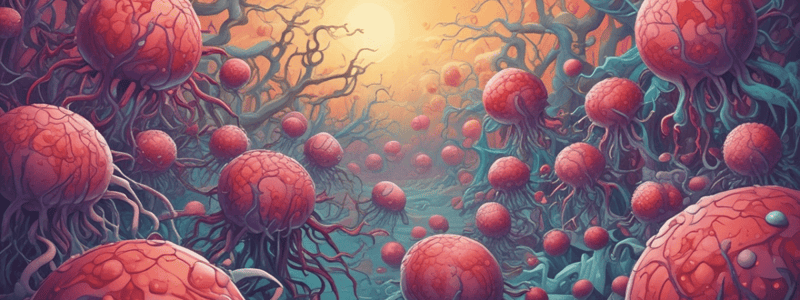Podcast
Questions and Answers
The A subunit of the AB-toxin is responsible for delivering the toxin into the correct cell.
The A subunit of the AB-toxin is responsible for delivering the toxin into the correct cell.
False (B)
The tetanus toxin produced by the bacterium Clostridrium tetani leads to an increase in neurotransmitter release.
The tetanus toxin produced by the bacterium Clostridrium tetani leads to an increase in neurotransmitter release.
False (B)
Each AB-toxin is associated with the same disease.
Each AB-toxin is associated with the same disease.
False (B)
Endotoxins are made by Gram positive bacteria.
Endotoxins are made by Gram positive bacteria.
A massive release of endotoxin in a host can cause fever.
A massive release of endotoxin in a host can cause fever.
Transmission of microorganisms can occur through a single route.
Transmission of microorganisms can occur through a single route.
Direct contact transmission involves touching, kissing, or sexual intercourse through inanimate objects.
Direct contact transmission involves touching, kissing, or sexual intercourse through inanimate objects.
Fomites are objects that cannot carry infection.
Fomites are objects that cannot carry infection.
Pathogenic microorganisms employ the same transmission mechanism.
Pathogenic microorganisms employ the same transmission mechanism.
Indirect contact transmission occurs through direct contact with an infected individual.
Indirect contact transmission occurs through direct contact with an infected individual.
Flashcards are hidden until you start studying
Study Notes
Adhesion and Establishment of Infection
- Bacterial pathogens require adhesion to host cells, colonization of tissues, and cellular invasion to establish infection
- Successful establishment of infection involves intracellular multiplication, dissemination to other tissues, or persistence and evasion of the host's immune system
Toxins
- Toxins are virulence factors produced by some bacterial pathogens, which are poisonous to the host
- Two categories of toxins: exotoxins and endotoxins
- Exotoxins are heat-sensitive, soluble proteins released by living bacteria
- Three categories of exotoxins:
- Type I: cell surface-active, stimulating cell responses
- Type II: membrane-damaging, forming pores in the target cell membrane
- Type III: intracellular, stimulating reactions within the target cell
- Examples of exotoxins: botulism, tetanus, and diphtheria
Virulence Factors (VF)
- Virulence factors (VF) are molecules that assist bacteria in colonizing the host at the cellular level
- Characteristics that contribute to virulence include physical structures (pili, flagellum, etc.) and chemical substances (toxins)
- Genes that code for virulence factors are often clustered on the pathogen's chromosome or plasmid DNA, called pathogenicity islands (PI)
- Quorum sensing (QS) controls the expression of virulence genes, ensuring activation when the pathogen population reaches an optimal density
Pathogenicity vs. Virulence
- Pathogenicity: the ability of an organism to infect a host and cause disease
- Aggressiveness: the ability of a pathogen to invade and establish within the host
- Virulence: the severity of disease in infected hosts (or degree of pathogenicity)
Ecological Relationship
- Normal flora: microorganisms that colonize the body and usually do not cause disease
- Opportunistic pathogens: harmless microbes that may cause disease under certain circumstances (weakened immune system or breach in natural defenses)
Transmission of Microorganisms
- Transmission can occur through direct contact, indirect contact, or vectors (insects)
- Fomites are objects or materials that can carry infection from an infected individual or reservoir
Studying That Suits You
Use AI to generate personalized quizzes and flashcards to suit your learning preferences.




